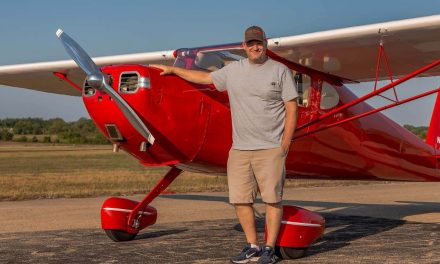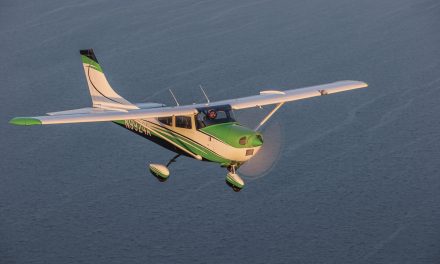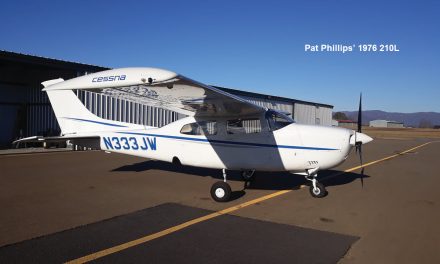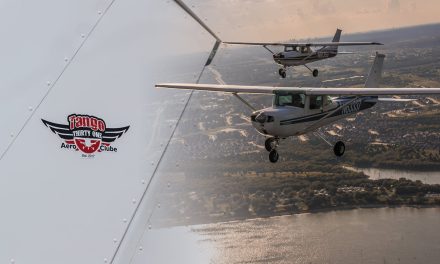 What happens when you transplant 195 hp onto the nose of a Skyhawk?
What happens when you transplant 195 hp onto the nose of a Skyhawk?
When the world’s largest manufacturer of general aviation airplanes decided to bring out a new model back in 1976, you can bet they’d researched the market and were convinced there were eager buyers waiting for it.
In the case of the Cessna Skyhawk XP, the Wichita company probably assumed they had a slam dunk winner. The airplane was, after all, a variation on the Skyhawk, the bestselling model on the planet. The XP was planned as an upgrade to the standard 172.
When the XP premiered in 1976, it was obvious to the rest of the industry that the Cessna 177 Cardinal’s days were numbered. Predictably, Cessna kept the Cardinal alive in the form of the Cardinal Classic until they had a chance to gauge the XP’s reception; then, to the chagrin of so many Cardinal lovers, they quietly dropped both the stiff-legged Cardinal and the Cardinal RG upon introduction of the 1979 models.
The XP wasn’t necessarily a new idea. Reims in France had been building the 180-hp Reims Rocket for years. Still, by US standards, the Hawk XP was something else. During the XP’s first two years on the market, Cessna sold a little over 1000 units, but such stellar sales were at least partially a function of pipeline filling, stocking up dealer inventories. After that, it was pretty much all downhill.
Certainly, sales in those first two years were a direct reference to the XP’s heritage. As most Cessna-watchers know, the XP stood for Extra Performance, and the new airplane was little more than a garden-variety Skyhawk with a bigger engine and constant speed prop bolted on out front.
The standard Skyhawk was the best-selling airplane in the world, its disciples were legion, and Cessna reasoned that a more powerful, firewall-aft carbon copy that incorporated all the easy-flying characteristics of the original couldn’t miss.
From the firewall forward, the Hawk XP substituted an injected, six-cylinder, Continental IO-360K in place of the standard, carbureted, four-cylinder O-320H Lycoming. Basically, the larger engine was a de-rated version of the mill used on Cessna’s own model 337 Skymaster push-pull twin. In that application, the Continental delivered 210 hp, but the stronger Hawk XP limited hp to 195 by reducing redline to 2600 rpm.
If you had any doubt as to whether that was enough to lift 250 pounds more gross weight, the Continental’s healthy rumble at idle helped make you a believer. On the ground during taxi and run-up, you couldn’t help but notice that this was a very different breed of Hawk. Nosewheel steering seemed a little stiffer because of the heavier engine, and the airframe transmitted a smoother set of vibrations from the extra two cylinders.
As any aerodynamicist will tell you, the primary advantage of more horsepower is better climb, since cruise speed increases only minimally with even fairly large power upgrades. In the Hawk XP’s case, 21 percent more power was aided and abetted by a constant speed McCauley prop. This resulted in about a seven-to-eight knot cruise increase.
With help from the Skyhawk’s standard high-lift wing, upward mobility improved from 770 fpm on the standard airplane to just under 900 fpm on the hot rod version. During my flights in a brilliantly renovated XP with from one to three people aboard, I saw a regular 1000 fpm on the VSI, so the 172XP is one of those airplanes apparently capable of better things at lighter weights.
Adding power also did good things for service ceiling and high altitude performance. The POH suggested a stock Hawk XP would climb to 17,000 feet before the rate of climb dropped to 100 fpm, whereas the stock Skyhawk is down to the same rate at only 14,200 feet. In more meaningful terms, since most pilots rarely have occasion to loft to such heights, summer density altitudes promised to be more manageable in the XP.
Though the climb difference was only a little over 100 fpm at sea level, it was about the same at 10,000 feet. Western pilots know that 10,000 foot density altitudes aren’t unusual on the ground in summer at high elevation airports. The difference between the standard Hawk’s 285 fpm and the XP’s 400 fpm at 10,000 feet seemed a lot larger.
Besides offering better climb, the gutsier Hawk XP might have been expected to haul more useful load, and in one sense, it did. Empty weight on a typical airplane was about 1600 pounds, leaving 950 pounds for people, baggage, and fuel.
Because of the larger engine’s more voracious appetite for avgas, the later XPs could be purchased with optional 66 gallon tanks. Top the big tanks, however, and payload dropped to about 550 pounds, three folks worth. Shut off the gas pump at 49 gallons, however, and you were left with a 650-pound allowance, still not a lot, but closer to the four folk ideal and at least 80 pounds better than the standard Hawk.
What the long range tanks offered in those situations when you could fill them was an extra 200-250 nm of range, depending on how big a hurry you were in. Level at 6500 feet pulling max cruise power, you could plan on burning about 12 gph and fly for five hours plus reserve on full tanks. At 130 knots, that translated to 650 nm—or Cleveland to Tallahassee nonstop. If you climbed on up to 9500 feet and pulled the left knob back to economy cruise, you could linger aloft for almost nine hours, traversing over 800 nm in the process. With a little help from prevailing Westerlies, Eastbound masochists willing to endure such hardships could fly nearly coast to coast with one fuel stop somewhere in Central Texas. More normal three-hour flights allowed a pilot to fill all seats and pump aboard 45 gallons without exceeding gross weight limits.
Inevitably, there were some XP operators who couldn’t care less about such long legs. The airplane’s better-than-average short field capability made it a semi-popular machine for the boonies. In places such as Alaska where the mission was most often short range and often to an abbreviated strip, the Hawk served as something of a poor man’s 206, though like the Stationair, the XP’s nosewheel limited it to fairly smooth runways.
On a cool day with a savvy pilot at the controls, the XP could be operated from unobstructed, 1300 to 1400-foot dirt strips. The airplane I flew did consistently better than book on both takeoff and landing distances, but even the manual claims an 800-foot takeoff run and 620 feet for landing, shorter than just about any other nosewheel aircraft in the class.
Part of the reason for the Hawk XP’s success in the outback was its large flaps. Any pilot who’s flown any Skyhawk knows that the flaps are about as effective as those of any airplane in the sky. Lowering full spoilers during approach dropped stall speed from 53 to 46 knots, so that using even 55 knots approach speed into a short strip wasn’t out of line.
Despite a heavier engine out front, elevator power remained better than average to hold the nosewheel off during and after the flare. With a little practice, most pilots could grease a Hawk XP onto the numbers or at least in the first 100 feet of runway practically every time.
As is so often the case with higher horsepower versions of popular models, it was tough to find much wrong with the more powerful Hawk, at least at first. Cabin room in back was marginal for full-size folks, and most pilots wouldn’t consider buying one without the optional vent fan to improve airflow, but the basic airplane retained most of what was good about the Skyhawk and sacrificed very little except for the obvious higher fuel flow.
Based on the published cruise specs for both airplanes, the lower-horsepower model achieved about 25 percent better mileage than the XP, a fact that weighed heavily on the minds of prospective buyers concerned not only with fuel cost but also fuel availability.
For some buyers, the primary concern was simply cost. In 1978, the Hawk XP listed at $41,050 compared to the standard airplane’s $31,850—nearly 25 percent more. That made the Hawk XP the second most expensive airplane in its class (predictably, the Beech Sundowner was more costly), followed closely by the well-established Piper Archer and the quick but unconventional Gulfstream-American Tiger.
The extra bucks did pay for some performance advantages, however. Though the XP was the heaviest airplane in the class by at least 100 pounds, it had the best rate of climb, the highest service ceiling, the lowest stall speed, and the shortest takeoff run. In addition, of course, the Hawk XP was still a Skyhawk, and that meant docile, forgiving handling and a willingness to endure whatever its owner(s) could throw at it.
The Hawk XP program lasted only until 1981 before falling on its sword. Some 1450 units were built before the airplane’s spate of engine problems caused it to be discontinued. The 180-hp Skyhawk, known as the Cutlass, assumed the mantle of most powerful Skyhawk until Cessna shut down all piston production in 1986.
The Hawk XP may have found its niche as a floatplane, as the higher power made it a better airplane coming up onto the step during a water takeoff. In whatever capacity it served, however, it remained a Skyhawk, and that was perhaps its most formidable recommendation.
Specifications
1979 Cessna Hawk XP
Engine: Continental IO-360K
HP: 195 @ 2600 rpm
Max gross (lbs): 2550
Empty Weight (lbs): 1541
Useful Ld (lbs): 1009
Fuel Cap (gal): 49 (66 opt)
Wing Area (sq ft): 174
Wing ldg (lbs/sq ft): 14.7
Power ldg (lbs/hp): 13.1
Max Cruise (kts): 130
Stall Spd (kts): 46
Climb rate (fpm): 870
Serv Clg (ft): 17,000
Takeoff dist (ft): 800
Ldg dist (ft): 620





